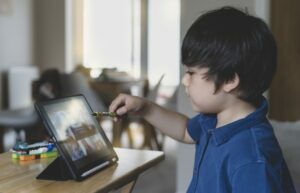When we think about creativity, we tend to think about artists and creating sculptures, symphonies or books. But creativity is central to learning and problem-solving. It is the ability to take what we already know and apply it in a different way. For example, we “know” that keys are for unlocking doors, but in a pinch they can also be used to get dirt out from under fingernails, turn those tiny screws on glasses, and rip open the plastic that comes on all sorts of things from food to kids’ toys. All those other ways to use keys are examples of “divergent thinking” which shows creativity!
It is becoming more important than ever to foster creativity in children because of the speed at which technology is changing our world. Learning one particular set of skills may not help much when the skills needed for a job change every year. Instead, children need to know how to take learned skills and apply them in different ways when needed.
And guess what? Creativity is also linked to happiness! Being creative, whether by drawing, writing or baking, is associated with better health and feelings of well-being. In fact, studies have shown that actually making or doing something with your own hands, even weeding a garden, has a number of benefits like relieving stress and feelings of depression.
So how can you help to grow creativity in your children and yourself? Here are a few tips:
- Give your child time to be creative. This means allowing your child time to be imaginative, play different games, make up stories, paint, sing, and generally explore. It also means less screen-and structured-time. That can be hard to come by in today’s busy world when parents work and there is not a lot of time between getting home, eating dinner, doing homework and going to bed. And “scheduling creativity” would seem counterintuitive. But you can allow free time in your child’s evening (or morning) so that she has the space to be creative. And you could use that same time to do something creative for yourself!
- Give your child the materials to be creative. This does not have to cost a lot and it is best if this not an out-of-the-box project. You could find some old magazine and let your child cut out pictures and create a collage. Or he can fill up glasses with different amounts (or kinds) of liquid to see what kind of music he can make. You can find gently used materials for all sorts of arts and crafts projects at your local thrift store. Some stores even put together bags of beads, yarn, fabric and other materials that would be perfect for creating.
- Don’t worry about the end product. It doesn’t matter whether your child creates the next great sculpture or the best poem. It is the process of thinking creatively and getting lost in creating that is important for both learning and well-being.
There is a good reason that adult coloring books are selling out of book and craft stores. We all have a need to be creative. And we can all benefit from it. So find some colored paper, or felt, or wood, or whatever cool materials you would like to work with, and let your and your child’s creative spirits take over for a while!
Sources
Creativity Happiness and Your Own Two Hands. https://www.psychologytoday.com/blog/the-creativity-cure/201205/creativity-happiness-and-your-own-two-hands
7 Ways to Foster Creativity in Your Kids. http://greatergood.berkeley.edu/raising_happiness/post/7_ways_to_foster_creativity_in_your_kids
Why Creativity in the Classroom Matters More than Ever. http://www.edudemic.com/creativity-in-the-classroom/
[divider type=”standard” text=”Go to top” full_width=”no” width=”1/1″ el_position=”first last”]
Image: © Oleksandr Grybanov | Dreamstime.com





